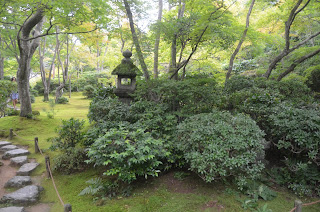Kyoto is the former imperial capitol of Japan and is famous for having a huge number of temples within the city, 1600 actually. You can pick from what tour guides, books or websites say or just wander the city and walk into any random temple you find. That is actually how I spent my first day in Kyoto. I wandered the city all afternoon and just walked into anything that looked interesting. One that I walked into was Rokkakudō Temple 六角堂(頂法寺), which was a small quiet paradise in the middle of the city and had serene ponds and a lovely temple and shrine. A pair of swans and their baby swam around as they cleaned the ponds.
 |
| Rokkakudō Temple 六角堂(頂法寺) |
 |
| Rokkakudō Temple 六角堂(頂法寺) |
 |
| Rokkakudō Temple 六角堂(頂法寺) |
 |
| Rokkakudō Temple 六角堂(頂法寺) |

Kyoto Beer Lab (京都ビアラボ) is a local brewpub that I would highly reccomend for a nice cold drink after a hot day walking around.
Heian Shrine (平安神宮) is a large shrine with a big gate and a garden. The shrine is free to visit but the garden costs money.
The garden is quite nice and for 1000 yen you get to walk all the trails and get a cup of tea and treat at the end. It's not the nicest garden I have seen in Japan but it was lovely to go for a nice walk.
Mikami-jinja Shrine (御髪神社) is right beside the garden and if you go up the stairs to the left of the shrine there are some free walking trails up the mountain to a lovely view of the city. I am pretty sure it is called Sagaogurayamacho (嵯峨小倉山町).
I enjoyed this even more than the garden although the vegetation is a lot less lush. We actually walked this all the way down to Takiguchi-dera Temple (滝口寺) and Giouji Temple (祇王寺). Giouji Temple also known as the moss temple. The temple is small but the little mos garden is so lush green with Japanese maples above it. I bet it looks spectacular in the fall as well with the red and green contrast.
Mikami-jinja Shrine (御髪神社) is right beside the garden and if you go up the stairs to the left of the shrine there are some free walking trails up the mountain to a lovely view of the city. I am pretty sure it is called Sagaogurayamacho (嵯峨小倉山町).
I enjoyed this even more than the garden although the vegetation is a lot less lush. We actually walked this all the way down to Takiguchi-dera Temple (滝口寺) and Giouji Temple (祇王寺). Giouji Temple also known as the moss temple. The temple is small but the little mos garden is so lush green with Japanese maples above it. I bet it looks spectacular in the fall as well with the red and green contrast.
 |
| Giouji Temple (祇王寺) |
 |
| Giouji Temple (祇王寺) |
Danrinji Temple (檀林寺) is right beside Giouji and has a small museum in it and a little pond. Although it is a small temple as well it has a fair number of relics in it but no information is in English. There were some Japanese Pygmy Woodpeckers on the property which are always an adorable treat to see.
 |
| Danrinji Temple (檀林寺) |
 |
| Danrinji Temple (檀林寺) |
Daikakuji Temple (大覚寺) is a large temple with walkways and a set route visitors can travel along. The temple is one of the largest I have seen in Japan up to this point and has many buildings and yards of stone or lawn.
 |
| Daikakuji Temple (大覚寺) |
 |
| Daikakuji Temple (大覚寺) |
Osawa-no-Ike Pond (大沢池) is beside Daikakuji Temple (大覚寺) and the entry fee gets you into both so don't miss a little walk by the pond and enjoy the view of lotus and waterbirds including grebes, herons and egrets.
 |
| Grebe in Osawa-no-Ike Pond (大沢池) |
Shingyo-Hoto Tower (大覚寺 心経宝塔) sits behind Hojo-ike pond (大覚寺 放生池) and is a lovely focal point behind the pond.
 |
Shingyo-Hoto Tower (大覚寺 心経宝塔) behind Hojo-ike pond (大覚寺 放生池)
|
 |
| Shingyo-Hoto Tower (大覚寺 心経宝塔) |
 |
| Shingyo-Hoto Tower (大覚寺 心経宝塔) |















No comments:
Post a Comment